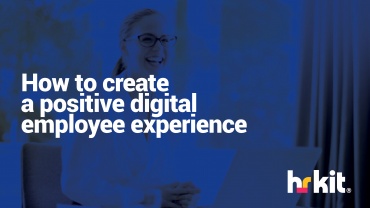How To Create A Positive Digital Employee Experience
All business people want to improve the experience of their customers and users. This is because these people give your enterprise its revenue so it’s obvious that they are valued. What many businesses don’t realize is how vital employees are to increasing profit. Your workers are connecting with the customers and users on a daily basis. They are the most valuable part of your company. Employees have an enormous effect on the quality of the customer’s experience. If the customer journey improves it will be due to the quality of the interactions with your employees.
Employee experience can be cultural, physical or digital. Most modern businesses rely heavily on technology for much of their work so the workers’ digital experience is important. This article about HR KIT gives you pointers in making the employee digital experience as positive as it can be.
Make it Personal
If you are a manager or leader you probably spend a lot of time in meetings with other executives and clients. You may have little interaction with the bulk of your employees. It is crucial to get to know your team so that you know what their experience is like. If you get to know your workers personally you will have a much better idea of what needs to improve. Talk to them.
You can find out your employees needs in a variety of ways. You might want to conduct a survey or commission reports from individual managers. One to one conversations can give you valuable information about workers’ problems and worries.
Communication is a Priority
Communication is one of the most important aspects of any successful business. Customers, users or employees’ experience is enhanced by the effective exchange of information.
There is a tendency for managers to be complacent about systems already in place but research suggests only 30% of workers are actively engaged with what they are doing.
Improvement means taking a look at your communication strategy and seeing what needs to change. Find out what your employees’ wants, needs and feelings are and act on the information you receive. You need clear and confidential information to enhance the employee digital experience.
Work as a Team
If you want to make permanent changes that work, everyone in the workplace needs to be on board with the initiatives you are putting in place. The digital experience needs to be tailored to the individual employee. Success will result in increased morale and productivity. Most workers do care and want to contribute if their ideas are listened to. You must ask for feedback on software you are testing out and new processes you are putting in place.
Dealing with Disengagement
Research suggests that many employees feel disengaged from the work they are doing. The statistics on disengagement are rising and it is rapidly becoming a global crisis. Feeling removed from their tasks leads to absenteeism amongst workers. In one year, 50 % of UK workers admitted to having a day off work where they pretended to be sick but they actually weren’t. Time off like this affects company productivity and puts pressure on the remaining members of staff. This can lead to stress levels going through the roof.
It is tempting to just write members of staff off as lazy but it’s not as simple as this. Staff will stop absenteeism if the feel connected to the goals and values of the organization. HR KIT is a specialist in employee engagement and we can help you obtain this vital feeling of connection.
The disengaged worker feels no pride in their role. They are apathetic to company aims and so they underperform. The lack of motivation means that productivity is low, absenteeism is high and staff retention is a problem. Research suggests that this situation is the norm for most employees. Only 15 % of the world’s work force feels engaged. The rest are uninterested with a minority being actively hostile to their employer. The hostile group may even sabotage the work of the company.
Disengagement is costing your business money. The estimated cost of absenteeism is 84 billion dollars annually. Companies spend 16 % of their salary bill covering the absence of staff. It is difficult to differentiate between genuine illness and fabricated sickness. Looking at businesses with high levels of engagement can help here. Information from Gallup tells us that companies that have a high score for employee engagement report 37 % lower rates of absenteeism than those at the bottom. Absenteeism may be costing businesses 31 billion dollars a year.
Research from the CEBR (Centre for Economic and Business Research) reveals that stress, anxiety and depression are the main causes of worker absenteeism. These mental health conditions account for 46 % of all work absence. When these employees were interviewed 44 % said their illness was due to their workload. 14 % of workers said they felt unsupported. Violence, threats and bullying were mentioned by 13 %. In addition, 8 % of employees said they were struggling with changes at work. We can see that overwhelm and feelings of disconnection are the main drivers behind absenteeism.
Inefficient methods of communication can make stress worse. Many employees waste time answering unnecessary emails and messages. This time wasting means they have less of the day to work on targets. Data from Harris Interactive suggest many workers don’t want to come to work in the morning and many dream of leaving and working for another company.
How to Minimise Disengagement
It is counter-productive to try to force your employees to engage. Being hard on sickness leave will just lead to more dishonest behaviour and a poor atmosphere. Instead, you need to make the place of work an environment that people want to be in.
You can build a better company culture by asking yourself some uncomfortable questions. What is making your employees call in sick? Is it lack of communication between low and high level workers? Perhaps the workplace teams are not speaking to each other enough. It could be that what the management want from the employees is not clear.
You need to create an atmosphere where open communication is welcome. If staff feel comfortable to voice their views you can find out their grievances. One person may be speaking for many.
Remember to include the entire workforce in your communication strategy. The majority of workers don’t sit at a desk all day. This means they often don’t have access to e-mail. Going mobile helps everyone to stay in touch.
HR KIT for a better, more happy workplace
People don’t need just an app. They need understanding and employers with vision. Our approach is employee-driven. We dreamt and delivered a platform with a promise to give employees what they need to engage in their work and their colleagues and drive results for the company and society.





